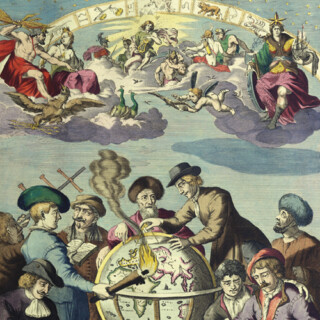Glossary of Terms for Collectors of Rare Maps, Atlases, Books, Globes and other related Scientific Objects.
Latin for first edition. The first printed edition of a work that was in circulation in manuscript before printing was invented. An edition includes all the impressions published at the same time or as part of the same publishing event. A first edition is one that was issued with the first published group of impressions. First edition prints and maps are sometimes pre-dated by a proof edition. Editions of a map or print should be distinguished from states of a map or print. There can be several states of from the same edition, and there can be several editions all with the same state. A limited edition print is one in which a limit is placed on the number of impressions pulled in order to create a scarcity of the print. Limited editions are usually numbered and are often signed. Limited editions are a relatively recent development, dating from the late nineteenth century. Earlier prints were limited in the number of their impressions solely by market demand or by the maximum number that could be printed by the medium used. The inherent physical limitations of the print media and the relatively small size of the pre-twentieth century print market meant that non-limited edition prints from before the late nineteenth century were in fact quite limited in number even though not intentionally so. German printmaker Adam von Bartsch, in his 1821 Anleitung zur Kupferstichkunde, estimated the maximum number of quality impressions it was possible to pull using different print media as follows: Engraving: Stipple: Mezzotint: Aquatint: Wood block: It was only with the development of lithography and of steel facing of metal plates in the nineteenth century that tens of thousands of impressions could be pulled without a loss of quality. These technological developments led to the idea of making limited edition prints, by which printmakers created an appearance of rarity and individuality for multiple-impression art. Paper, often of coated or marbled stock, with one half pasted to the cover; used primarily to give a finished appearance to the binding. Danish: Begyndelsesark An intaglio technique characterized by clean tapered lines made by incising a metal plate (traditionally copper) with a sharp tool called a burin. A range of line widths is possible depending on the size of tools used, making delicate tonalities also possible. The incised lines hold the ink when the image is pressed. Engraving is the technique most commonly seen in Old Master prints. Also sometimes used to refer to an illustration in a book made using the process. Transitory single sheet printed matter not intended to be retained or preserved. The word derives from the Greek, meaning things lasting no more than a day. French: Vieux Papiers A list of errors and misprints in the text of a book. The list might be printed on a bound page in the book or on a separate piece of paper that is pasted or laid in the book. An intaglio technique with a visual result similar to drawing, etched lines are usually free with blunt terminations as a result of the artist drawing with a sharp tool through a soft, often wax-based, ground coated on the plate. Volume and contour is created using a technique called hatching, where the artist changes the spaces, angles, lengths and qualities of the lines. The plate is then placed into an acid bath, where the acid eats away, or “bites,” the exposed metal of the incised lines leaving the areas that are coated with ground untouched. The artist can achieve a broad range of tonality with etching by controlling the time the plate spends in the acid-bath. A Latin phrase meaning "from the books" or to paraphrase, "from the library or collection of"; the phrase is frequently used on bookplates. Usually a volume made into a unique copy with additional illustrations, autographs, or manuscripts added by carefully gluing or tipping-in this extra material.
Glossary
E
Editio Princeps
Editio Princeps

Edition
Edition
500 (and about the same number of weaker images)
500 (and about the same number of weaker images)
300 to 400, though the quality suffers after the first 150
Fewer than 200
Up to 10,000
Endpaper
Endpaper
Dutch: Blad van het voorwerk
French: Gardes
German: Vorsatz
Italian: Foglio preliminare
Spanish: Hoja preliminar
Swedish: Eftersättsblad
Engraving
Engraving

Ephemera
Ephemera

Errata
Errata
Etching
Etching

Ex-libris
Ex-libris

Extra-illustrated
Extra-illustrated








